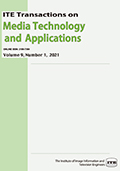Volume 9, Issue 1
Displaying 1-14 of 14 articles from this issue
- |<
- <
- 1
- >
- >|
Special Section on Advanced Imaging and Computer Graphics Technology
-
2021Volume 9Issue 1 Pages 1
Published: 2021
Released on J-STAGE: January 01, 2021
Download PDF (408K) -
2021Volume 9Issue 1 Pages 2-12
Published: 2021
Released on J-STAGE: January 01, 2021
Download PDF (1217K) -
2021Volume 9Issue 1 Pages 13-24
Published: 2021
Released on J-STAGE: January 01, 2021
Download PDF (4045K) -
2021Volume 9Issue 1 Pages 25-32
Published: 2021
Released on J-STAGE: January 01, 2021
Download PDF (1635K) -
2021Volume 9Issue 1 Pages 33-41
Published: 2021
Released on J-STAGE: January 01, 2021
Download PDF (7884K) -
2021Volume 9Issue 1 Pages 42-53
Published: 2021
Released on J-STAGE: January 01, 2021
Download PDF (2740K) -
2021Volume 9Issue 1 Pages 54-61
Published: 2021
Released on J-STAGE: January 01, 2021
Download PDF (1294K)
Special Section on ITE Awards Selection
-
2021Volume 9Issue 1 Pages 62
Published: 2021
Released on J-STAGE: January 01, 2021
Download PDF (401K) -
2021Volume 9Issue 1 Pages 63-70
Published: 2021
Released on J-STAGE: January 01, 2021
Download PDF (2329K)
Regular Section
-
2021Volume 9Issue 1 Pages 71-79
Published: 2021
Released on J-STAGE: January 01, 2021
Download PDF (5818K) -
2021Volume 9Issue 1 Pages 80-85
Published: 2021
Released on J-STAGE: January 01, 2021
Download PDF (3701K) -
2021Volume 9Issue 1 Pages 86-94
Published: 2021
Released on J-STAGE: January 01, 2021
Download PDF (2192K) -
2021Volume 9Issue 1 Pages 95-104
Published: 2021
Released on J-STAGE: January 01, 2021
Download PDF (2432K) -
2021Volume 9Issue 1 Pages 105-112
Published: 2021
Released on J-STAGE: January 01, 2021
Download PDF (3994K)
- |<
- <
- 1
- >
- >|
